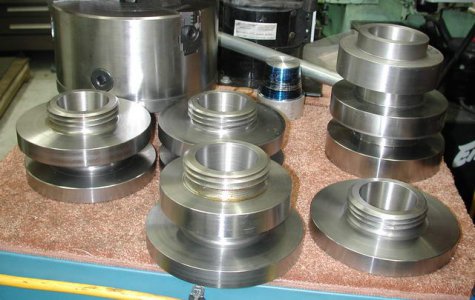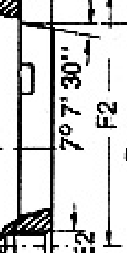-
Welcome back Guest! Did you know you can mentor other members here at H-M? If not, please check out our Relaunch of Hobby Machinist Mentoring Program!
You are using an out of date browser. It may not display this or other websites correctly.
You should upgrade or use an alternative browser.
You should upgrade or use an alternative browser.
How do I read this angle?
- Thread starter wax64
- Start date
Thank you! I'll read up on it I had no idea how to look this up
- Joined
- May 7, 2023
- Messages
- 1,500
Or, converted to decimal degrees: 7.125 Degrees.
7 + 7/60 + 30/(60*60) = 7.125 Degrees (If my coffee is working this morning...)
In my workshop, the answer would be 7 Degrees plus a skosh.
That probably won’t be good enough for a spindle nose.
Max, how much is your time worth to you?
You’re going to play hell getting that taper right, especially as there is most likely a shoulder or pocket involved.
This is a situation where if at all possible I would purchase the back plate.
If I was going to try and match the angle on the lathe nose set the compound to match it with an indicator. Then mount the new backing plate and machine the angle. It won’t matter what the angle is. The back plate will match the angle.
- Joined
- Jan 8, 2020
- Messages
- 178
Yep. But make sure both the indicator tip and the tool tip are on centerline; any height error will result in an angle error.If I was going to try and match the angle on the lathe nose set the compound to match it with an indicator. Then mount the new backing plate and machine the angle. It won’t matter what the angle is. The back plate will match the angle.
- Joined
- May 7, 2023
- Messages
- 1,500
A whole bunch of this.Yep. But make sure both the indicator tip and the tool tip are on centerline; any height error will result in an angle error.
Ive done it before using this method and even then there was some fitting needed. That part was an open ended taper and I was making everything around it so there was plenty of wiggle room, but it still needed 3-4 tried to get it perfect.
Also, runout was not a concern in my case, but if you need to take it out of a chuck, check fit and adjust/re-bore it this will become a concern.
- Joined
- Dec 10, 2023
- Messages
- 79
Or, converted to decimal degrees: 7.125 Degrees.
7 + 7/60 + 30/(60*60) = 7.125 Degrees (If my coffee is working this morning...)
In my workshop, the answer would be 7 Degrees plus a skosh.
That probably won’t be good enough for a spindle nose.
Max, how much is your time worth to you?
You’re going to play hell getting that taper right, especially as there is most likely a shoulder or pocket involved.
This is a situation where if at all possible I would purchase the back plate.
If I was going to try and match the angle on the lathe nose set the compound to match it with an indicator. Then mount the new backing plate and machine the angle. It won’t matter what the angle is. The back plate will match the angle.
I agree with the above, particularly by RaisedbyWolves. Buy if you can.Yep. But make sure both the indicator tip and the tool tip are on centerline; any height error will result in an angle error.
But... if you are going to set a specified angle, the best process I've come across for setting a compound is by Joe Piecznski in this video. However, in your case, one of matching an existing angle, use the indicator on the spindle itself.
A friend and I machined 10 backplates for an pre-WWII Rivet 1020 (my avatar image) L00 spindle nose. Some of the resulting backplates would "stick" to the spindle, indicating the taper was that close, some don't, but they all worked. I would have bought the backplates, but the threads were 4 tpi, which was proprietary by Rivett. Only ones available were 6 tpi.
Rick

- Joined
- May 7, 2023
- Messages
- 1,500
I agree with the above, particularly by RaisedbyWolves. Buy if you can.
But... if you are going to set a specified angle, the best process I've come across for setting a compound is by Joe Piecznski in this video. However, in your case, one of matching an existing angle, use the indicator on the spindle itself.
A friend and I machined 10 backplates for an pre-WWII Rivet 1020 (my avatar image) L00 spindle nose. Some of the resulting backplates would "stick" to the spindle, indicating the taper was that close, some don't, but they all worked. I would have bought the backplates, but the threads were 4 tpi, which was proprietary by Rivett. Only ones available were 6 tpi.
Rick
View attachment 489924
I have an L-00 on my Clausing and for that deep of a taper indicating it would be much easier and the result more forgiving of any error.
With the OPs drawing is seems there’s only 1/2” or so to indicate, not optimal at all.



